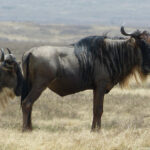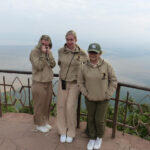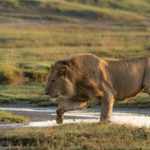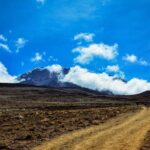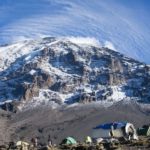You’re more likely to spot leopards in dense forested areas than cheetahs in open savannahs. But which safari destination provides the ultimate viewing experience for these elusive big cats? Let’s delve into the dynamics of their habitats and sightings to unravel this mystery.
Leopards are predominantly found in sub-Saharan Africa and parts of Asia, thriving in their diverse habitats. Cheetahs, conversely, favor the grasslands of East Africa, particularly the Serengeti and Maasai Mara. Interestingly, about 75% of Africa’s cheetah population is found in non-protected areas, making sighting them even more challenging.

Habitat Preferences of Cheetahs and Leopards
Cheetahs prefer open landscapes like grasslands and savannas. These environments offer them the space needed for their incredible speed while hunting. The Serengeti in Tanzania and the Maasai Mara in Kenya are prime spots for cheetah sightings. They avoid densely forested areas where leopards dominate. Their need for open space makes protected areas less ideal than unprotected regions.
Leopards, on the other hand, thrive in a variety of environments, including forests, mountains, and even urban areas. Their adaptability allows them to coexist with humans more readily than cheetahs. In Africa, leopards are widespread in sub-Saharan regions. They also inhabit parts of Asia, from India to China. This wide range demonstrates their versatile nature.
Rolux Safaris often plan their tours to enhance the chances of seeing both cheetahs and leopards. They understand the specific habitats where each of these big cats are most active. With guided tours, visitors can explore prime locations known for frequent sightings. Expert guides provide valuable insights into the behaviors and experiences of these majestic animals. The company’s deep knowledge ensures an enriching safari experience.
The habitat preferences of cheetahs and leopards play a crucial role in their ecology and conservation. While cheetahs need wide-open spaces to survive, leopards show remarkable flexibility. This difference in habitat preference affects their numbers and conservation status. Knowing where to look for these big cats helps in their protection. Rolux Safaris’ expertise in locating them offers a responsible way to enjoy these sightings.
Exploring Rolux Safaris best locations for Cheetah and Leopard safaris
The Serengeti National Park is a prominent destination offered by Rolux Safaris. This vast grassland in Tanzania is ideal for spotting cheetahs. With wide-open spaces, the Serengeti provides the perfect backdrop for witnessing their incredible speeds. Guided tours here maximize your chances of seeing cheetahs in action. The timing of visits is crucial as daylight offers the best viewing conditions.
Another exceptional location is the Maasai Mara Reserve in Kenya. Renowned for its diverse wildlife, this reserve is home to both cheetahs and leopards. Rolux Safaris has expert guides to navigate the terrain and pinpoint the best viewing spots. Early morning and late afternoon tours offer the best opportunities. Spotting these elusive cats is often a highlight of any safari adventure.
For those interested in leopards, South Africa’s Kruger National Park is a top choice. Dense bush and varied landscapes make it a favored habitat for leopards. Rolux Safaris ensures experienced guides who can track these stealthy predators. The park’s infrastructure provides good access to prime leopard habitats. Tourists often have multiple sightings in a single safari.
Namibia’s Etosha National Park also offers excellent viewing opportunities. Unlike the dense landscapes of Kruger, Etosha’s salt pans and open plains are perfect for cheetahs. Rolux Safaris plans itineraries that balance both cheetah and leopard sightings. With strategic campsites and guided game drives, visitors can experience the thrill of spotting both big cats. Wilderness camps enhance the safari experience, bringing you closer to nature.
Spotting Opportunities in African Safari Destinations
African safari destinations offer unparalleled opportunities to observe cheetahs and leopards in their natural habitats. The Okavango Delta in Botswana is a unique spot where water meets wildlife. Known for its dense vegetation, it provides excellent conditions for leopard sightings. Rolux Safaris includes boat rides through the delta for a unique viewing experience. The diverse ecosystem supports a rich array of wildlife.
In Zimbabwe, Hwange National Park stands out for its large elephant herds and predator populations. Cheetahs here are often seen in the more open areas of the park. Rolux Safaris plans routes that maximize the chances of encounters with these graceful hunters. The park’s vast landscape offers multiple habitats. Visitors often witness thrilling chases on the plains.
Uganda’s Queen Elizabeth National Park is another excellent destination, particularly for predator spotting. Tree-climbing lions dominate here, but leopards are also common. Rolux Safaris enhances this experience with knowledgeable guides who know where leopards like to hide. Boat safaris along the Kazinga Channel offer a different perspective. The park’s scenic beauty adds to the adventure.
In Zambia, South Luangwa National Park is famed for its walking safaris. This park’s varied habitats are home to both cheetahs and leopards. Rolux Safaris equips visitors with the expertise needed to track these elusive animals on foot. The Luangwa River supports abundant wildlife. Night drives also provide a chance to see nocturnal activities.
Behavioral Patterns That Impact Sightings
Understanding the behavioral patterns of cheetahs and leopards is crucial for successful sightings. Cheetahs are diurnal, meaning they are active during the day. They hunt primarily in the early morning and late afternoon. This makes them easier to spot during safaris at these times. Rolux Safaris schedules their tours accordingly to maximize viewing opportunities.
Leopards, in contrast, are nocturnal and more elusive. They are primarily active during twilight and nighttime. Leopards spend a significant amount of time resting in trees or hidden within dense vegetation. This behavior makes daytime sightings more challenging. Rolux Safaris often incorporates night drives to increase the chances of spotting these stealthy predators.
The movement patterns of these big cats also affect sightings. Cheetahs travel widely across open spaces in search of prey. Their need for speed dictates an environment with minimal obstacles. Leopards, meanwhile, have smaller territories and are more territorial. They often patrol the same areas over and over, making it easier to track them once their territory is known.
Predator-prey interactions further influence sighting chances. Cheetahs tend to avoid areas with high densities of larger predators like lions and hyenas. Thus, sighting a cheetah often means fewer encounters with these other predators. Leopards, being solitary hunters, are more versatile in choosing prey and habitats. This adaptability allows them to coexist with other large carnivores.
The presence of cubs can also impact visibility. Female cheetahs with cubs are more secretive and cautious, thus harder to spot. Leopards are particularly protective of their young, often hiding them in dense foliage. Tours with Rolux Safaris are designed to be respectful of these instincts. Guides ensure that the wildlife is observed without causing stress or disturbance.
- Cheetahs are active during the day.
- Leopards are more active at night.
- Cheetahs travel widely, while leopards patrol smaller territories.
- Predator presence, such as lions, affects cheetah sightings.



